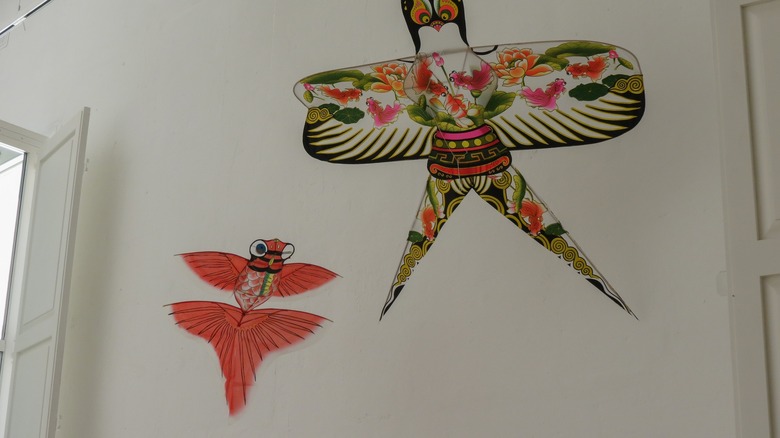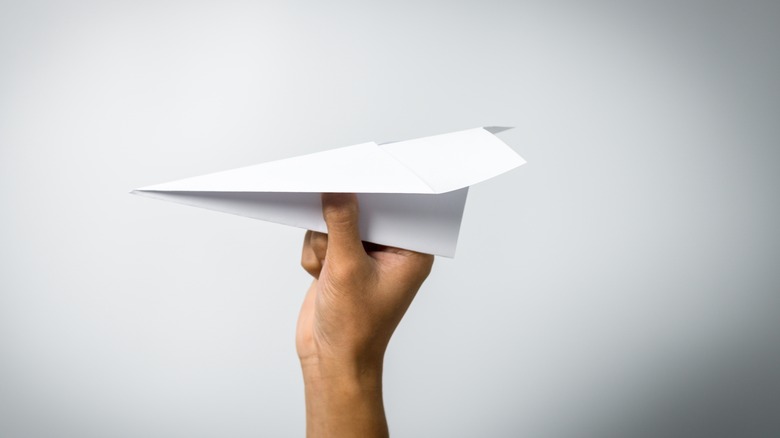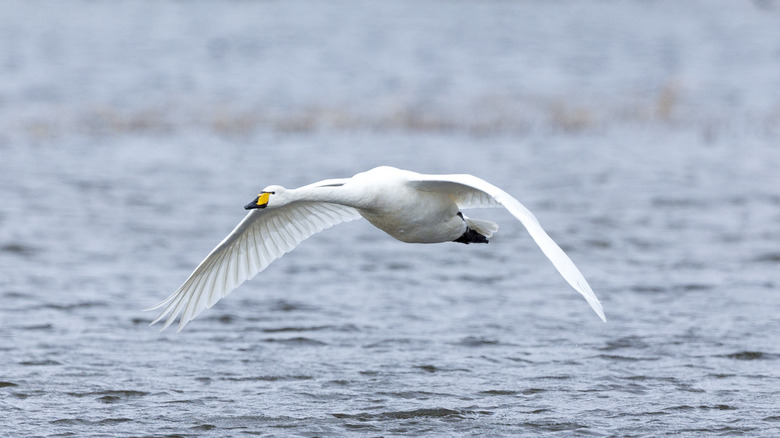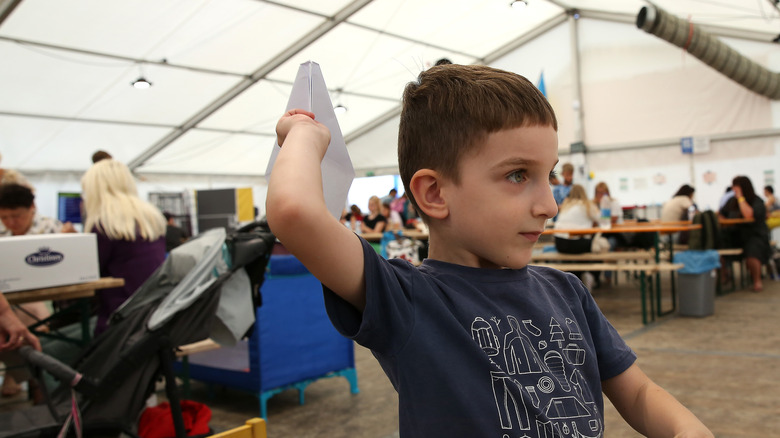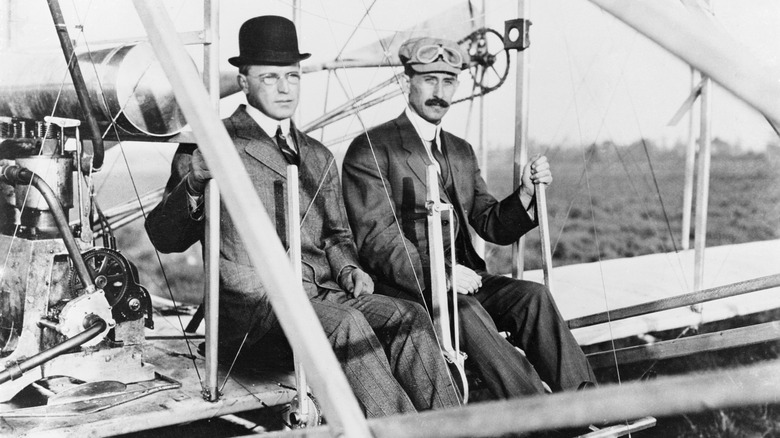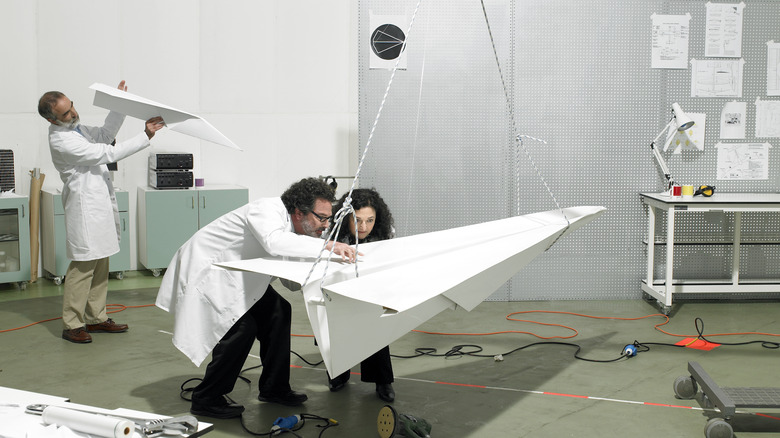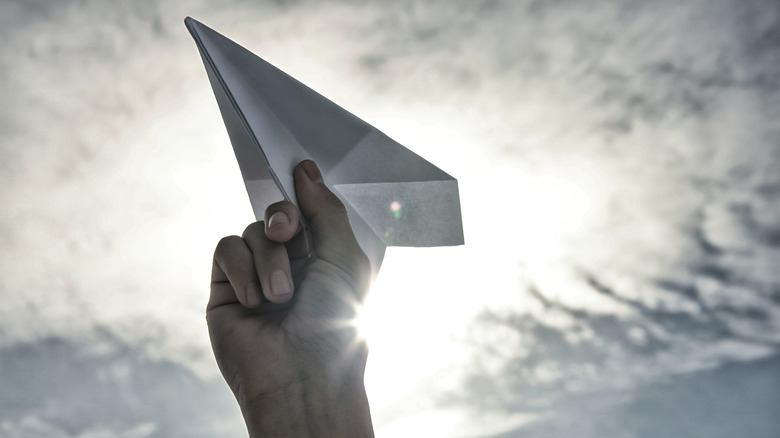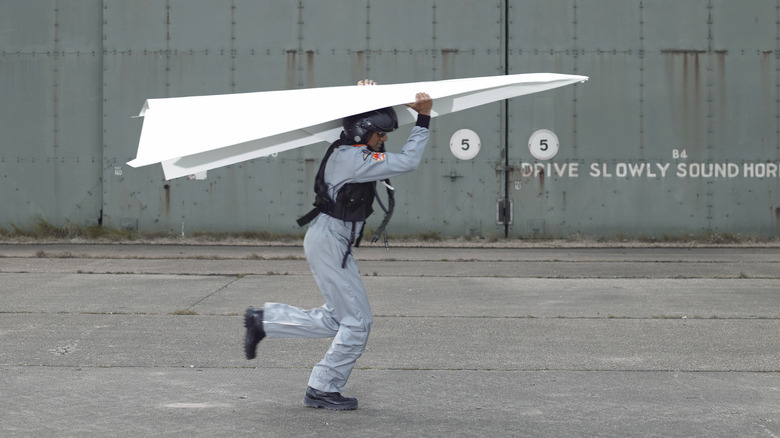Why Paper Airplanes Have A More Important History Than You Realize
Paper airplanes are something that kids all over the world are familiar with. After all, they are a toy that can be made almost anywhere as all you need is a piece of paper and the ability to fold it into various aerodynamic shapes. This makes paper airplanes incredibly accessible and popular as there's very little to stop anyone from creating one wherever they are.
As well as being good at annoying teachers and seeing how far they can be thrown, paper airplanes actually have a long — and notably important — history that stretches back further than you might have imagined. People have launched paper airplanes from space and flown giant versions over the deserts of Arizona, as two notable examples. Here, SlashGear takes an in-depth look at the evolution of the humble paper airplane and the role it has played in the history of avionics, research, and more.
The first paper airplanes originated in ancient China
Although aircraft are a relatively modern invention, what most people might consider paper airplanes actually have a much longer history. It isn't exactly clear when paper airplanes were first developed but there is some evidence to suggest that societies in ancient China and Japan may have had contraptions that could glide through the air. For example, there are records that indicate kites made from papyrus paper were used in China before becoming more widespread throughout the country.
Historians believe that these gliders first arrived more than 2,000 years ago. In fact, there is evidence that puts some of these gliders having been constructed as early as 500 B.C. Along with papyrus paper, linen and bamboo were also used to construct gliders, with other countries in Asia — including Malaysia and Indonesia –also developing primitive gliders around the same time.
What these gliders looked like is not well known, but it is unlikely that they resembled the paper airplanes that we know today. Some may have looked quite elaborate to take the shape of birds and others were likely basic kite shapes. Outside of being used as a way of understanding the world and experimenting, these gliders and kites had more practical uses. General Han Hsin is said to have used a kite to measure the distance his army would have to dig to tunnel under a protective wall.
They were originally called paper darts
Notably, despite the fact that paper airplanes have been around for a very long time, they didn't always go by that name. Before the airplane was invented the term simply wasn't in use, so the contractions were known as paper darts. That makes sense given that there is evidence that darts are some of the oldest tools used by humanity since prehistory, used as weapons to hunt animals and fight against other tribes.
There are references to the term paper darts as far back as 1864, with children making and flying paper darts for fun. In fact, there are even books that give instructions on how to fold paper to create paper darts that can fly effectively through the air. These designs are almost exactly the same as the most common and popular methods used today, demonstrating that paper airplanes are not a modern concept and the only difference between these early versions was that they went under a different name.
Other reference books from the late 1800s and early 1900s recount that paper darts were often used as practical jokes and to be annoying. They were thrown in class by children and the New York Stock Exchange explicitly banned its members from throwing paper darts when the board was in session. So these paper darts were used for pretty much the same purposes as paper airplanes today.
Early paper airplanes had flapping wings
Although the term paper darts was used for what we would consider paper airplanes today, with angular shapes and straight lines, there are references to paper aeroplanes all the way back in 1890. However, this wasn't a term that was used to describe the same sort of construction as paper darts. Instead, they referred to more bird-like creations that many people believed would resemble real-life flying machines of the future.
That was because a common belief during the late 1800s was that any man-made machine capable of flying would have to copy the mechanics of birds or other flying animals with flapping wings to achieve lift. Scientific American published a method for constructing a paper aeroplane in 1984 that was called the albatross.
This idea was built on the work of Leonardo da Vinci. The famed inventor studied the possibility of man-made flight extensively during his career and made numerous paper models to test his designs for potential flying machines. However, most of these tried to replicate the mechanics of animals such as bats, The limited knowledge of aerodynamics at that time meant that these concepts were impractical and unable to fly or glide.
The name didn't change until the 1960s
While the term paper aeroplane was used for some types of paper airplanes, the name paper dart stuck around for a long time. There are a number of reasons for this, the main one being that the name just stuck because it had been in use so long and there was little need to change it. Of course, there's also the fact that even when man-made airplanes did start to fly, they looked nothing like the paper airplanes that people were making, which much more closely resembled a dart or spear.
That began to change during the mid to late 1900s. A few decades earlier, prototypes began to emerge that looked much more like a paper dart, with straight edges and an angular design. This concept evolved into modern day fast fighter jets that often have delta-wing designs that are shaped like a sharp triangle cutting through the air. Thanks to the fact that these fighter jets take on the same form as paper darts, more people began to call them paper airplanes as they had a proper real-life analog. Of course, the cool nature of fighter jets would likely also have meant kids would want to associate their paper creations with them rather than mere darts.
The science behind paper airplanes is the same as for real aircraft
The actual science behind how paper airplanes fly is much the same as with real aircraft. They need to be aerodynamic enough to slice through the air relatively easy with as little drag as possible, while also being light enough to lessen the effect of gravity on bringing the model back to Earth. Thrust is provided by the thrower rather than engines, forcing the paper airplane to move forward. As it does so, air passing the wings causes lift that pushes the paper airplane up and helps keep it in the air. Eventually the lack of thrust causes it to no longer be able to remain at the correct position in the air so that drag and gravity overcome the lift provided by the wings.
There are some notable differences, though, between an aircraft such as a fighter jet or passenger jet and a paper airplane. For starters, paper airplanes don't have any form of power outside of the force imparted by the thrower. This means that they can't adjust flight angles or acceleration during the air, leading to them having to rely on the right throwing angle and speed to achieve the best glide over a sustained time. Different designs require modified angles and velocities to get the best results.
Early engineers used paper airplanes to experiment with aerodynamics
Paper airplanes have a number of key advantages that make them the perfect way to experiment with aerodynamics. Paper is cheap and in abundance, so it is not difficult to get a lot of it to create many samples for testing. The flexibility and lightweight nature of the material also means that it is perfect for making into a variety of different designs without the need for complicated machinery and equipment. Researchers can simply pick a design and start folding or cutting with their hands.
This is perhaps why so many early engineers looking at the possibility of manned flight used paper darts. Sir George Cayley is widely credited with effectively inventing the airplane in the early 1800s after he discovered the four forces involved in flight and understood that a fixed-wing design would work better than flapping wings. He constructed a number of models to help illustrate his ideas and test them, often using paper to do so. Meanwhile, the Wright Brothers also utilized paper when they were in the early stages of developing their own aircraft. The pair constructed paper wings and even tested them in a primitive wind tunnel to help simulate flight in the air.
Some scientists are still using paper airplanes to study flight stability
While the days of paper airplanes being essential to studying aerodynamics and flight are over, some scientists still use them for occasional research. A study published in 2002 from New York University revealed that researchers have been conducting experiments into paper airplanes as a way of better understanding flight stability. The study helped scientists discover new aerodynamic effects focused on gliding and mathematical models for predicting how long the paper airplanes could stay in the air.
"The study started with simple curiosity about what makes a good paper airplane and specifically what is needed for smooth gliding," said a New York University associate professor who worked on the study. "Answering such basic questions ended up being far from child's play. We discovered that the aerodynamics of how paper airplanes keep level flight is really very different from the stability of conventional airplanes."
The hope is that this research could have several important applications in the real world. A better understanding of flight stability and gliding over long distances could be essential to developing smaller aircraft that don't have the same kind of thrust as larger jets. This could include tiny flying robots as well as automated drones.
An entire industry around paper airplanes sprang up
The popularity of paper airplanes reached a peak during the mid to late 1900s when books began to be published on the subject, giving children and hobbyists information about how to craft a wide variety of different paper airplanes. Modern software such as computer-aided design (CAD) systems as well as ink and laser printers also allowed people to craft paper airplanes to exact specifications, achieving better results than what was known possible before.
A major driving force in increasing the popularity of the paper airplane was the advent of manned flight as well as the space race. There was an increased cultural focus on aerodynamics and aircraft of all types, leading to children and adults alike creating paper airplanes as a way of joining in and imagining they were part of the fantastic scientific achievements that were happening at the time.
As people began to have a deeper and more sophisticated understanding of aerodynamics, paper airplanes became more advanced. Modern versions are able to fly longer and at higher speeds than ever before, with online sources providing the means for anyone to replicate designs.
Computer-aided design and more sophisticated models have overtaken the need for paper airplanes
In the modern era, the need for paper airplanes as a research tool has diminished. In fact, physical models are not as widely used as they once were, due to the rise in computer-aided design systems and software. Aircraft designs go through a number of stages before construction begins, from the conceptual stage where engineers create sketches of what the aircraft might look like to the detailed design when every single part is accounted for. Long before parts are physically tested in a wind tunnel or in the air, they go through extensive computer testing.
This is often done with CAD, where detailed images of aircraft can be created to give engineers and designers a complete overview of how every aspect of the vehicle will look. These CAD files can be used for everything from creating designs for large vehicles and equipment to sharing controller modifications for Valve's Steam Deck. Computational fluid dynamic software is also used to simulate air flow and determine how parts of the aircraft will interact with the air as it moves. These allow designers to quickly make changes to the design and see how they will affect the performance of the aircraft without the need to build models. They are so effective that they are used by everything from F1 teams to design racing cars to NASA as a way of being able to explore space.
Paper airplanes are mainly used to beat records for flight time and distance
Outside of recreational purposes, the main way that paper airplanes are used today is for record-breaking purposes. There are numerous records that enthusiasts try to beat, although they are mainly focused on distance and time aloft, which is the time the paper airplane spends in the air. However, there are also records for accuracy and more obscure feats that test how much control users have over the paper airplanes.
As well as an official competition that is held every five years, people have set records in all kinds of places. These include the largest ever paper airplane that had an almost 60-foot wingspan and the longest distance for a plane that flew 289 feet by American Dillon Ruble. Takuo Toda of Japan holds the record for time aloft, constructing and throwing a paper airplane that managed to stay in the air for just under 30 seconds. Meanwhile, David Rush of the USA holds the fastest time for constructing and throwing a paper airplane in a time of 6.15 seconds.

